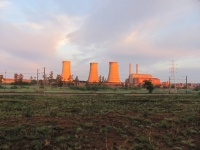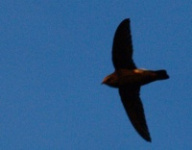

I have been wanting to visit Rooiwal Sewage Works (chapter 36 in Birding Gauteng) for weeks but struggled to get through on the number provided but I found a cell number for the contact person (Marietjie Wolmarans - 0721903474) and she kindly emailed me permission to visit the spot. I arrive at the crack of dawn (5:30) and watched the sun rising and illuminating the cooling towers of the Rooiwal Power Station. I spent a little while at the Apies River bridge where I saw Little Swift and African Palm Swift flying overhead as well as Hadeda Ibis, Common Myna, Southern Masked Weaver and White-breasted Cormorant.
As I drove around the power station towards the main entrance of the Sewage Works I pull over as I heard the unmistakable sound of Northern Black Korhaan - they were on either side of the road and I was able to get fairly close to one of them in the field on the other side of the fence (this area also had Cattle Egret, Common Fiscal, White-winged Widowbird, Crowned Lapwing and Black Shouldered Kite):
There was no one manning the entrance gate or at reception (it was only 6am!) so I spent a while birding around the gardens where I saw Cape Sparrow, Cape Turtle Dove, Laughing Dove, House Sparrow and Blacksmith Lapwing. I was itching to move on so I headed down to the upper ponds where I saw Cattle Egret, Grey-headed Gull (and what looks like an Immature bird as well), White-winged Tern and Wattled Starling. It felt a little thin in terms of birds but I recalled reading in Birding Gauteng that the Lower Ponds are the place where the most birds are found. I did not take any scenery pics in this area in case it presents a security risk.
The Lower Ponds lived up to their reputation. I was able to bird from my car for about an hour (I find that I can get closer to birds in my car compared to walking up to them - plus I have the benefit of using my window as a tripod - especially in poor light conditions - on this morning it was cloudy and the sun would come and go which made it really tough to get settings right for consecutive shots!). All in all I saw: Little Stint, Common Sandpiper, White-faced Duck, Black-winged Stilt, Little Grebe, Red-knobbed Coot, Egyptian Goose, Southern Red Bishop, Red-billed Teal, Barn Swallow, Squacco Heron, Little Egret, Hadeda Ibis, White-faced Duck, Brown-throated Martin, Reed Cormorant, Hottentot Teal, Ruff, Marsh Sandpiper, African Darter, Wood Sandpiper, Reed Cormorant, Southern Pochard, Yellow-billed Duck, Cape Wagtail, Common Moorhen and White-throated Swallow. I have decided to group these pics rather than present them in the order they were taken.
I made my way down to the Lowest Ponds - this seems to be the last stage in the water purification process, before the water is released into the Apies River. Judging by the smell around the lowest ponds and the scum on the surface, I don't think I would drink from the Apies River downstream in a hurry!!!
I parked my car and took a walk around the series of three large ponds. It was a great experience as the bird life on the ponds was decent and also below the ponds there is a reed filled wetland with great birds as well. I saw: African Palm Swift, African Jacana, African Stonechat, Tawny-flanked Prinia, African Reed Warbler, Red-collared Widowbird, Long-tailed Widowbird, Thick-billed Weaver, Black Crake, Spur-winged b, Burchell's Coucal, White-winged Widowbird, African Purple Swamphen, Red-billed Teal, Southern Red Bishop, Southern Masked Weaver, Levaillant's Cisticola, Grey-headed Gull, African Reed Warbler, Egyptian b, White-faced Duck, Wood Sandpiper, Three-banded Plover, Black-headed Heron, White-throated Swallow and African Pipit.
Here are birds I saw on the pond:
Here are the birds I saw around the reeds:
As I arrived back at my car I noticed two White-throated Swallows and I nearly got whiplash trying to capture them while in flight:
It was about 8 o'clock by now and I did not feel like leaving the place, so I decided to move through the three layers of ponds a second time. The purification plant had come alive by now and there were more vehicles around - and a lot of construction work taking place on the property. Here is what I saw on my second time around: A flock of birds flying overhead (including different species of Hadeda and Egrets - I would find out later where they were heading), White-winged Tern, Wood Sandpiper, African Pied Wagtail, Three-banded Plover, Cape Wagtail and Little Swift. I captured what I believe is a juvenile African Pied Wagtail - unfortunately I searched in vain for Yellow Wagtail on the day!
I spent a bit of time around the reception area to see if I was missing anything and saw: Helmeted Guineafowl, Southern Red Bishop, Southern Masked Weaver, Cape Sparrow and Lesser Striped Swallow.
It was time to move on so I left the property to bird the agricultural fields on the other side of the road. First I did a bit of roadside birding from my car (nothing more than a few African Pipits) and deciding against driving on the muddy roads took off on foot to check out the bird activity around the huge sprinkler system out in the fields. This helped me solve the mystery of the large flock of birds that flew overhead - they were heading to these irrigated fields to feed. I saw another Northern Black Korhaan on the way and even got a picture in which three Hadeda species are in the same pic - Glossy, Sacred and Hadeda. I also spotted Crowned Lapwing and Cattle Egret in the fields. Some of the Sacred Ibis are a strange golden brown colour - I am not sure if that was just dirt of a morph of sorts.
My final stop was on a side road next to the entrance to the Power Station that leads down to the Apies River - the original bridge is still there - and it proved to be a great little spot for Dark-capped Bulbul, Tawny-flanked Prinia, Rattling Cisticola, Southern Masked Weaver and Black-throated Canary.
This spot is not as beautiful as the Sewage Works in Polokwane (which is actually proclaimed as a Bird Sanctuary) and has more large trees growing in the area and numerous bird hides but for the amount of birds it cannot be matched. In the 4 and a half hours I spent there (let's just say that the smell does not make you want to linger too long!) I saw 69 bird species. I headed off to the Bon Accord Dam which is just down the road as I desperately needed to spend time in a pleasant environment for a while before heading home.